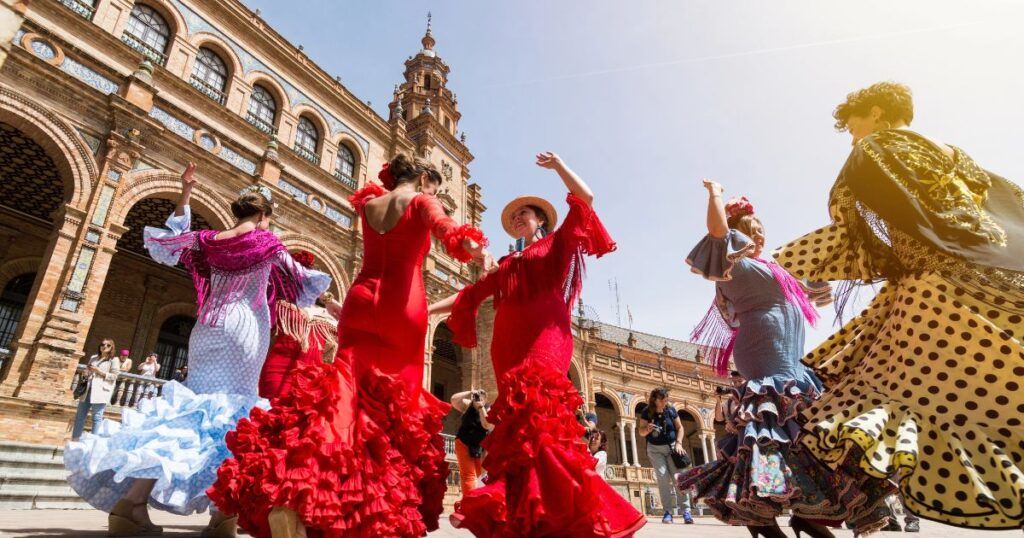Ultimate Spain Travel Guide
Dreaming of Spain? Whether you’re craving sunny coastlines, rich history, or tapas-inspired indulgence – this Spain travel guide is here to help you plan with confidence, comfort, and a dash of adventure.
This comprehensive travel guide gives you the best of Spain: when to go, where to stay, what to pack, and how to avoid common tourist traps. Written with boomer travelers in mind, you’ll get practical tips and insider insights (plus that Rioja glass in hand vibe you’re after).
Consider it a forever guide – updated as needed to keep you roaming smarter.
What To Know At A Glance
- Language: Spanish is the national language, but you’ll also hear Catalan, Basque, and Galician in their respective regions.
- Currency: Euro (€)
- Spain is part of the Schengen Area. U.S. visitors can stay up to 90 days in a 180‑day window.
- Best Time to Visit: Spring (April–June) and fall (September–November) offer great weather and fewer crowds. But don’t overlook a winter visit.
- Spain is bigger than you think. It has 17 autonomous regions, each with distinct food, festivals, and cultural traditions.
- Trains are great—but don’t ignore buses. They’re affordable and reach towns the high-speed rail may not.
- Late dinners and Sunday closures are normal. Adjust your expectations – restaurants open late, and Sundays are blissfully quiet.
- Pickpockets target tourist zones. Stay alert in crowded areas like Barcelona’s La Rambla or Madrid’s Puerta del Sol.

Why Visit Spain?
Spain is one of those rare countries that seems to have it all – ancient cities, modern art, lazy beach towns, dramatic mountain landscapes, late-night flamenco, and food that somehow manages to be both rustic and gourmet at the same time.
It’s a place where Roman aqueducts live just down the street from hip tapas bars, and where daily life still honors traditions like the siesta – because of course lunch deserves three hours and a nap.
Whether you’re wandering the Moorish palaces of Andalusia, strolling along Barcelona’s beachfront, or sipping wine in the Rioja countryside, Spain offers the kind of rich, layered experience that can’t be rushed – and shouldn’t be.
For baby boomers especially, Spain hits a sweet spot: it’s culturally rich without being overly complicated, relaxed without feeling sleepy, and filled with opportunities to explore at your own pace (with just the right amount of olive oil involved).
Popular Destinations in Spain
Spain is wonderfully diverse, with each region offering its own unique flavor (literally and figuratively). Here are some of the most popular places to visit—and why they’re worth a spot on your itinerary.
Madrid
The capital city has a little bit of everything: world-class museums (hello, Prado), leafy parks, grand boulevards, and a food scene that knows how to stretch from tapas to late-night churros. It’s a great base for day trips to places like Toledo or Segovia – and it runs on energy, not sleep.
Barcelona
Art, architecture, and beaches, all with a Catalonian twist. You’ll find Gaudí’s whimsical buildings, bustling markets like La Boqueria, and a seaside promenade perfect for people-watching. Just keep an eye on your purse while you’re at it – Barcelona is beautiful but famously pickpocket-prone.

Seville
If Spain had a romance capital, this would be it. Think flamenco shows, orange-scented courtyards, and Gothic-meets-Moorish architecture. It’s also the birthplace of tapas – so really, enough said.

Granada
Home to the Alhambra, one of the most stunning architectural wonders in Europe. Granada blends Islamic history, dramatic mountain views, and a bohemian vibe into one compact, magical city.
Valencia
Modern architecture, a vibrant old town, and paella straight from the source. Valencia tends to fly under the radar, which is part of its charm – bonus points for its beautiful beaches and walkable city center.

San Sebastián & the Basque Country
Up north, the Basque region feels like a different world. San Sebastián is a foodie paradise, renowned for its pintxos (the Basque version of tapas), Michelin-starred restaurants, and breathtaking coastal views.
Andalusia’s White Villages (Pueblos Blancos)
Dotting the hills between Seville and Málaga, these picture-perfect towns – like Ronda, Arcos de la Frontera, and Grazalema – are steeped in history and wrapped in whitewashed charm. A road trip through this area is slow travel at its finest.
Planning Your Spain Trip
Best Time to Visit
Spring (April–June) and fall (September–October) are ideal for most of Spain. The weather is pleasant, the crowds are lighter, and you won’t melt into the pavement like you might in July or August. If you’re heading south to Andalusia, spring is especially lovely.
Getting to Spain
Most international travelers fly into Madrid or Barcelona. Both cities are major hubs with plenty of flight options, and either one makes a great starting point depending on your itinerary. Spain also connects easily to the rest of Europe by train or budget airline.
Getting Around Spain
Spain has one of Europe’s best train systems, including high-speed AVE trains that make cross-country travel easy and comfortable. That said, don’t overlook the intercity buses—they’re often cheaper, air-conditioned, and serve smaller towns trains don’t reach.
If you’re exploring rural areas or planning a road trip through Andalusia or the Basque region, renting a car gives you more flexibility. Just be prepared for narrow streets and roundabouts that seem to multiply like rabbits.
Where to Base Yourself
If you’re a first-timer, Madrid and Barcelona are obvious choices and offer great day trip opportunities. Seville makes a beautiful base for exploring southern Spain, while Valencia is perfect for combining culture with beach time.
If you’re moving around, consider staying a few nights in smaller towns like Ronda, Girona, or Salamanca to get a feel for Spain beyond the big cities.
Roam Like a Local
Adjust to the rhythm
Spaniards operate on a slightly different schedule—lunch around 2pm, dinner at 9 or 10, and nightlife that starts when most boomers are in their pajamas. You don’t have to fully adopt it (unless you’re a night owl), but knowing the rhythm helps avoid empty restaurants and closed shops.
Embrace the menú del día
This fixed-price “menu of the day” is a lunchtime gift from the travel gods. You’ll get a multi-course meal (often with wine) for a very reasonable price. Locals love it, and savvy travelers should too.
Don’t expect speedy service
Meals in Spain are meant to be savored, not rushed. Waiters won’t hover, and you’ll probably need to ask for the check when you’re ready to go. Consider it permission to linger.
Brush up on basic Spanish
You don’t need to be fluent, but a few polite phrases—hola, por favor, gracias—go a long way. In more rural areas, English isn’t as common, so having a translation app handy helps.
Dress like you care a little
Spaniards generally dress neatly, even for casual outings. You don’t need to pack a blazer for sightseeing, but maybe leave the athletic shorts and white socks at home.
Take Sundays seriously
Many shops and restaurants close for part—or all—of Sunday. It’s a day for family, leisure, and very little hustle. Plan so you’re not caught hangry and wandering.
The Good, the Bad, and the Quirky
The Good
- The food and wine: Tapas, paella, jamón ibérico, local wines—need we say more? Every region has its specialties, and they’re usually affordable and delicious.
- The ease of travel: Spain’s trains, buses, and regional airports make it simple to get around. You can cover a lot of ground without a lot of hassle.
- The lifestyle: There’s something magical about the slower pace, the outdoor café culture, and the importance placed on living well. Spain is unapologetically unhurried, and it’s kind of contagious.
- Value for money: Compared to many Western European countries, Spain gives you a lot of bang for your buck—especially outside of the big cities.
The Bad
- Pickpockets: Tourist-heavy areas like Barcelona’s La Rambla and Madrid’s metro are hotspots for light fingers. Crossbody bags, zipped pockets, and staying aware go a long way.
- Business hours confusion: Siesta hours and Sunday closures can catch travelers off guard. Always double-check hours, especially in small towns.
- Service culture: Don’t mistake a lack of check-ins from your waiter as rudeness. In Spain, lingering is encouraged—and flagging down the bill is totally normal.
The Quirky
- Late-night energy: In cities, it’s not unusual to see toddlers out with their parents at 11 pm. Spaniards take their social lives seriously, regardless of the hour.
- Early Bird Dinner? Forget It: Spain dines late. If you’re an earlybird diner, well, you’ll likely be eating lunch, not dinner.
- Tiny elevators, big staircases: Many older buildings have minuscule lifts – or none at all. Consider it accidental cardio.
- Ham is a national treasure. You’ll spot entire legs of jamón hanging from the ceilings of bars and markets like prized décor. And if you order a bocadillo? Don’t expect lettuce and tomato – just a crusty baguette with a glorious slab of ham. Simplicity, Spanish-style.
What to Pack for Spain
Spain’s climate varies by region and season, so what you pack will depend a bit on when and where you’re going. That said, there are a few universally smart items for just about any Spanish adventure.
- Comfortable walking shoes
Cobblestones, hills, and ancient streets are no joke. Leave the flimsy sandals behind and opt for something stylish and supportive. - Layers for all seasons
Even in summer, mornings and evenings can be cool—especially in the north or higher elevations. Lightweight layers are your friend. - Daypack or crossbody bag
Keep your hands free and your belongings secure. Crossbody bags with zippers or anti-theft features are great for crowded cities. - Travel umbrella or packable rain jacket
Spring and fall can bring surprise showers, particularly in the north. A compact umbrella or rain layer is easy insurance. - Sun protection
Sunglasses, a sunhat, and sunscreen are musts—Spain gets sunny, even in the shoulder seasons. - Plug adapter
Spain uses the standard European plug (type C or F) and 230V. A universal adapter will keep your gadgets charged. - Clothing with a little polish
Spaniards tend to dress smart-casual, even for everyday errands. You don’t need to overthink it—but you also don’t want to look like you just finished a workout.
Do You Need a Visa for Spain?
If you’re a U.S. citizen visiting Spain as a tourist, the good news is—you likely don’t need a visa. Spain is part of the Schengen Area, which allows Americans to stay up to 90 days within any 180 days without a visa.
That said, you will need:
- A valid passport (with at least 6 months of validity beyond your planned stay)
- Proof of onward travel (like a return flight)
- Travel insurance is highly recommended, and sometimes required for entry, depending on circumstances
Important: Rules can change, especially with the introduction of new systems like ETIAS (a travel authorization for Schengen countries, expected to roll out soon). Always check the latest entry requirements on the U.S. State Department website or the official Spain consulate page.
Frequently Asked Questions About Traveling To Spain
Is Spain a safe country for tourists?
Yes, Spain is generally very safe for travelers. Violent crime is rare, but pickpocketing can be a problem in crowded tourist areas. Stay alert, especially in places like La Rambla in Barcelona or on busy metro lines in Madrid.
Do people speak English in Spain?
In larger cities and tourist areas, yes, many people speak at least some English. But in smaller towns and rural regions, Spanish is essential. Learning a few basic phrases will go a long way (and earn you friendlier service).
What is the tipping culture in Spain?
Tipping is appreciated but not expected in the same way as in the U.S. Rounding up or leaving 5–10% in restaurants is common, but no one will chase you down if you don’t tip. Small coins for taxis or hotel porters are polite but not required.
Can I drink the tap water?
Yes, tap water is safe to drink throughout most of Spain. In some rural areas, people may prefer bottled water for taste, but it’s not a safety issue.
Is Spain expensive to visit?
Spain offers great value, especially compared to many other Western European countries. Food, transportation, and accommodations are generally affordable – particularly if you explore beyond the biggest tourist cities.
Conclusion: Is Spain Worth Visiting?
Absolutely. Spain is one of those rare destinations that manages to be relaxing, culturally rich, wildly flavorful, and surprisingly affordable – all at the same time.
Whether you’re in it for Moorish palaces, Mediterranean sunsets, art museums, or lazy café mornings with churros and thick hot chocolate, Spain serves it up in style. And for boomers especially, it strikes just the right balance of comfort and adventure.
So yes – Spain is worth visiting. Again, and again, and again.
And if you’re craving a multi-country visit, consider a France add-on. It’s right next door!
Remember, keep calm, and roam on.
Europe Travel Planning Essentials
The short answer – YES! The long answer – YES! Travel insurance is not just for travel delays and cancellations. More importantly, it can cover medical emergencies. That’s super important because your own health insurance probably won’t cover you outside your home country.
Our go-to travel insurance provider – Travel Guard
Entry documentation varies depending on your citizenship and your length of stay. If you are visiting from the U.S., you will need a passport. Visas may be required if you are planning a stay of more than 90 days. Check here for your specific requirements.
If you’re booking hotels by the night rather than a package or a tour, our go-to hotel site is Booking.com.
If you want an apartment or hotel – VRBO.
Use Rail Europe for point-to-point rail tickets and multi-day rail passes.
Auto Europe is great for booking car rentals anywhere in Europe.
Try Skyscanner!




